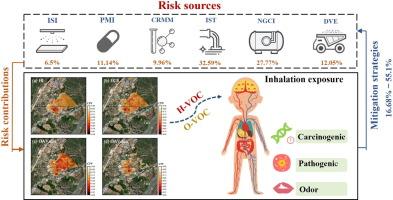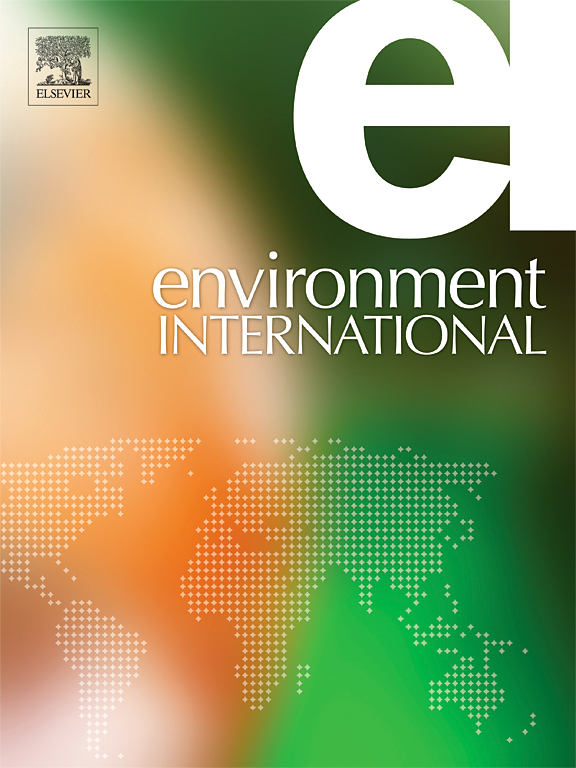以风险为导向的工业园区挥发性有机化合物来源分配及其对减缓战略的影响:从气味污染和健康风险中得到的启示
IF 10.3
1区 环境科学与生态学
Q1 ENVIRONMENTAL SCIENCES
引用次数: 0
摘要
本研究以长江经济带上游的一个典型工业园区(距重庆市中心 70 公里)为研究对象,调查了有害挥发性有机化合物(VOCs)的发生和暴露情况。采用暴露风险法和风险导向源分配法分别评估了吸入风险和挥发性有机化合物源分配。建立了风险因素与污染源之间的定量关系,确定了主要的致病性和恶臭挥发性有机化合物。根据风险阈值制定了定量减排策略。工业园区内的居民面临着致病性挥发性有机化合物和异味带来的潜在健康风险,特定行业的工人面临的风险比居民区的工人高出 2 到 6 倍。工业园区内确定了六个风险源,根据其对挥发性有机化合物浓度的贡献程度排序如下:工业污水处理(IST)(32.59%)、天然气化工行业(NGCI)(27.77%)、柴油车尾气(DVE)(12.04%)、医药制造业(PMI)(11.14%)、化学原料制造业(CRMM)(9.96%)和钢铁行业(ISI)(6.5%)。其中,NGCI、IST 和 CRMM 是致病风险的最大贡献者,对非致癌风险的贡献率分别为 32.13 %、29.71 % 和 21.71 %,对致癌风险的贡献率分别为 18.15 %、19.87 % 和 27.99 %。与其他来源相比,DVE 产生的臭气污染要高得多,其强度是其他来源的 3 到 10 倍。不同来源的主要致病性和异味挥发性有机化合物各不相同,因此对不同种类的挥发性有机化合物的控制重点也不同。减少这六个排放源中 20 种高风险物质(如丙烯醛、2-氯甲苯、1,2-二溴乙烷、二氯甲烷和对二乙基苯)的排放将同时降低致病性和异味风险,累计减排率从 4.11% 到 93.75% 不等。这项研究从健康风险的角度提供了挥发性有机化合物的量化控制目标,为工业园区制定风险管理政策提供了宝贵的指导。本文章由计算机程序翻译,如有差异,请以英文原文为准。

Risk-oriented source apportionment and implications for mitigation strategies of VOCs in industrial parks: Insights from odor pollution and health risks
A typical industrial park in the upper reaches of the Yangtze River Economic Belt, which is 70 km from the Chongqing urban center, was used to investigate the occurrence and exposure of harmful volatile organic compounds (VOCs). An exposure risk method and a risk-oriented source apportionment approach were performed to assess the inhalation risks and apportion VOC sources, respectively. The quantitative relationships between risk factors and pollution sources were established, identifying key pathogenic and odorous VOCs. The quantitative emission reduction strategies were developed based on risk thresholds. Residents within the industrial parks face potential health risks due to pathogenic VOCs and nuisance odors, and workers in specific sectors experience two to six times higher risks than those in residential areas. Six risk sources were identified in the industrial park, ranked according to their contribution to VOC concentrations as follows: industrial sewage treatment (IST) (32.59 %), natural gas chemical industry (NGCI) (27.77 %), diesel vehicle exhaust (DVE) (12.04 %), pharmaceutical manufacturing industry (PMI) (11.14 %), chemical raw materials manufacturing (CRMM) (9.96 %), and iron and steel industry (ISI) (6.5 %). Among these, NGCI, IST, and CRMM were the top contributors to pathogenic risks, with contributions of 32.13 %, 29.71 %, and 21.71 % to non-carcinogenic risks, and 18.15 %, 19.87 %, and 27.99 % to carcinogenic risks, respectively. DVE produced significantly higher odor pollution compared to other sources, with intensities that were 3 to 10 times greater. The key pathogenic and odorous VOCs differ by source, resulting in varying control priorities for different VOC species. Reducing emissions from these six sources for 20 high-risk species (e.g., acrolein, 2-chlorotoluene, 1,2-dibromoethane, dichloromethane, and p-diethylbenzene) will simultaneously lower pathogenic and odor risks, with cumulative reduction rates ranging from 4.11 % to 93.75 %. This study provides quantitative control targets for VOCs from a health risk perspective, offering valuable guidance for developing risk management policies in industrial parks.
求助全文
通过发布文献求助,成功后即可免费获取论文全文。
去求助
来源期刊

Environment International
环境科学-环境科学
CiteScore
21.90
自引率
3.40%
发文量
734
审稿时长
2.8 months
期刊介绍:
Environmental Health publishes manuscripts focusing on critical aspects of environmental and occupational medicine, including studies in toxicology and epidemiology, to illuminate the human health implications of exposure to environmental hazards. The journal adopts an open-access model and practices open peer review.
It caters to scientists and practitioners across all environmental science domains, directly or indirectly impacting human health and well-being. With a commitment to enhancing the prevention of environmentally-related health risks, Environmental Health serves as a public health journal for the community and scientists engaged in matters of public health significance concerning the environment.
 求助内容:
求助内容: 应助结果提醒方式:
应助结果提醒方式:


